Ruth Even Haim, Co-Founder at StilyoApps, and John Tedesco, CEO at Drip, joined EmberTribe's very own founders to chat about opportunities and challenges facing eCommerce brands, how to use customer feedback to build better SaaS products, and what it takes to be a good leader.

The following interview excerpts from episode two of Founders Forum have been edited for length and clarity. You can download the full transcript here.
In this interview:
Introductions
Josh: All right. Welcome to our second episode. And this is just a series where we get a chance in a round table format to dive behind the scenes and talk to some founders and executives, and really just help our community of entrepreneurs level up wherever they are. Learn from other's mistakes. Copy people's wins and take it from there. So Ruth, why don't you take it away? I'd love to introduce you first.
Ruth: Nice to meet you all. I am Ruth. I'm the co-founder of StilyoApps. We develop apps for eCommerce in general, mostly for Shopify, and Reconvert currently serves over 30,000 Shopify merchants from all sizes, providing post-purchase upselling and retention tools.
Josh: Fantastic. Thank you for joining us and John over to you.
John: Hi, I'm John Tedesco. I am the CEO of Drip. Super excited to be here. Thanks for having me on. Drip is an email and SMS marketing automation platform serving eCommerce merchants, helping them build their brand and grow their revenue. We've got over 7,000 customers across the globe, 80 employees, and we've generated over a billion dollars in revenue for our customers over the past couple of years.
Josh: Well, we're thrilled to have both of you, on this episode and I figured where we could start is the last year. At the time of this recording, we're looking back on a year of a pandemic, which has been a very interesting time in our space, which we're lucky and fortunate that we've had a lot of success in our space during this time period.
What are some challenges and opportunities facing D2C eCommerce brands as they're growing?
Josh: As you're looking forward, and John we’ll start with you as you're looking forward into 2021. What are some of the challenges, but also some of the opportunities facing direct-to-consumer eCommerce brands as they're trying to grow in scale?
John: Yeah, so I think as you look at 2020, the methodology for the consumer around online purchasing has now been permanently altered for the positive for D2C brands. And I think the greatest indication of that has been kind of, you know, when you see groceries and grocery shopping, which used to be the most tangible hands-on type purchasing now being done with, per service providers, Instacart, et cetera.
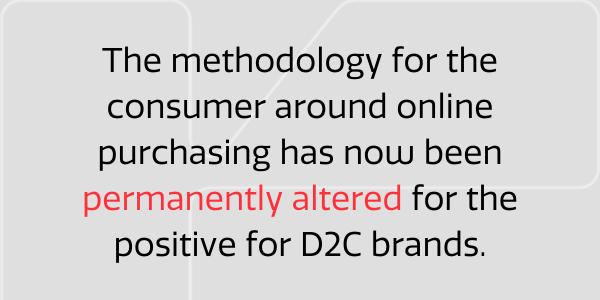
When, you know, when you used to have to touch produce, when now that has crossed over to online, then I think the world is open for all services and goods to be transacted online. So, and again, we talk about, you know, 10 years being fast-forwarded over the last year with, COVID. So I think online as being a method or the primary method, actually not shifting from a, from a certain minority purchasing to the method of purchasing has now opened up the playing field.
John: The challenges I would foresee is a lot of noise, a lot of competition, a lot of complexity. And so it's really going to be hard for brands, harder for brands to stand out and differentiate what their unique selling proposition is and to get a cut through the noise and get into the mind share of these consumers who now have a plethora of choices. And so I think the ability of a brand, whether it's brands like Drip or D2C brands themselves to have an authentic and meaningful value proposition, is going to be critical, in general, because that's the core. And then the ability to amplify that through all of the channels possible to get in front of their audience is going to be critical to success.
Josh: Absolutely. Yeah. Ruth, what's your take on this upcoming year’s challenges and opportunities?
Ruth: So I really agree with what John said about basically the fact that eCommerce has grown so much this year creating so much more competition, and this will force brands to focus more on retention and not just on selling and getting new customers in. But actually just making the most out of each customer, each existing one, by creating an actual relationship and just building something that is more than just a store that is selling to customers.
Josh: Definitely. Yeah. I think one thing that we're seeing, you know, on the media buying side is just as these platforms continue to get more expensive and there's more competition. Like there's more opportunity, but there's more competition and these brands need to start looking beyond customer acquisition and they need to be looking at repeat purchase rates and the whole post-purchase experience.
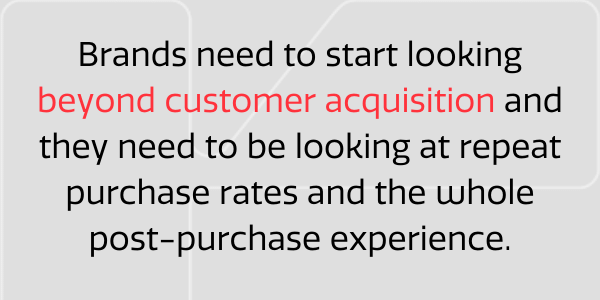
Why should D2C businesses pay attention to repeat purchase rates and customer retention?
Josh: Reconvert does this in spades, but what are some of the ways that your brands are making use of the tool and how does that kind of impact, I guess their overall unit economics of acquiring new customers?
Ruth: So we see two different roads that stores usually go in. So basically upselling and cross-selling on the thank you page, getting the customer to buy again before they even left the store. And for a lot of people, it sounds like something that is not very realistic. Like most customers would finish the purchase and they already bought, but it's not actually true. A lot of customers are like warm customers when they get to the thank you page. We can see people going from basically a 0% thank you page all the way to a 5% conversion rate for people who are really doing it well. And this just increases the bottom line for a customer that ideally already returned the investment on the ads or however you got into the website.
Josh: Absolutely. Yeah. I mean, I think what you're highlighting and underscoring there is just that you can't ignore these intermediary steps in the funnel; every piece counts to your bottom line and in an increasingly competitive space, you have to make use of things like a thank you page or things like an upsell sequence. So all of those touchpoints matter. And I think we're seeing that even more this year, like you're saying, John, I've been hearing for years, that email is dead, and yet all I'm seeing is more and more email, especially in the eCommerce world. So talk to us a little bit just about maybe those post-purchase sequences, how your customers are using drip to continue engaging with their clients.
John: Yeah. So, email's dead, long live email. I think at a high level here taking a step back a lot of what direct-to-consumer people think about as kind of a channel. But in reality, the power of direct-to-consumer is owning the customer relationship. And in the old days, you'd put the product on a shelf, at the Targets or the Best Buys or the merchant, they own that relationship. The customer came to that store, that brand, and they checked out and they had that data on that customer.
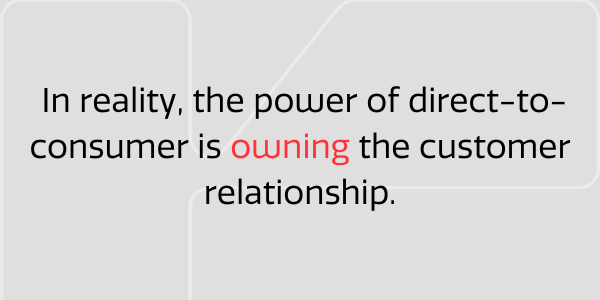
So email and direct ownership, you know, that is that identity. Now that relationship is directly with the brand. And while you may use a channel for paid media acquisition, once you capture that email address, you can start a direct relationship.
John: I think the second piece is we really have to be careful that we don't lose the humanity in the entire process here. Like we should be trying to replicate physical world relationships in a digital world. So when I hear things about sequences and funnels, and this is the challenge of our industry and we have to kind of, you know, cause we're in it all day long and we program it in the platform, we should really be thinking about a relationship we're trying to build with the customer. How would you act in a physical world and then how do I replicate that in a digital world? So, the initial purchase immediately, our customers should be asking, how was that first?
John: You know, how was that initial [experience]? Did it meet your expectations? Because that's really the trajectory for that customer relationship going forward. If it's negative, it's an opportunity to understand and salvage it. If it's positive, now you're starting to build a path in which you can have repeat purchases or have them move towards a loyal customer base. And so when you think about all of that, then you work backward and say, what information do I want to capture digitally to then feedback into my business? The outputs will be greater lifetime value, greater repeat purchasing, shorter CAC, but really think about that relationship because at the end of the day here, if you have a loyal customer base, which will generate, you know, the industry 60 to 80% of your lifetime revenues, that's also the foundation in which you create, um, word of mouth, influencer, marketing, et cetera.
And so for using Drip, what we're helping our brands do is, map out that customer journey in a digital way to help them capture this information and then really put them on a path towards better understanding. And then again, either giving them products, they want recommending products, or if it's a suboptimal experience, how do you capture more data? How do you contact the customer? And that is the information we're just helping them power digitally through the platform.
Josh: That's really good. I love that point just about focusing on relationships and then these tools, either the ones that you're building or that we have available to us in the industry should be amplifying and extending that relationship. And so I think what I'm, what I'm getting at, even from the other end of this is if you have a bad experience, these tools will only amplify about experience. So it's important to get that.
John: You know, when you have another human or you're facing another human, you would act very differently. If you can read the body expression, you can see their face. You know, you can see if they have a return in their arm or not. You know, you're just losing all of those signals. And the key is at the end. I think, you know, we sit in our offices or our home offices and look at screens all day and we forget that there's another human on the other end of the line. And that's why the biggest challenge I think, is in the digital side, is this loss of customer intimacy.
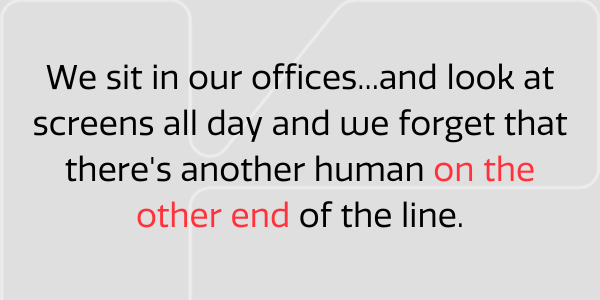
And that's why communities and voices and being embedded, no matter whether you're a service provider, like Ruth or I, or you're the brand itself, you got to remember there's another human at the other end, who cares about, or wants to care about kind of what you're doing. And that's kind of going back to the bright, bright, greater brand positioning, but I think sometimes you would get so lost in the tools. We forget kind of the bigger picture of what we're trying to accomplish.
Josh: Hundred percent. That's great. Let's actually take that angle and flip it on its head. So that's great advice for the DTC brands who need to maybe dig in a little bit more to that qualitative insight from their customer and to get closer to the customer.
How do you collect user research to get insight into the end-users of your product?
Josh: But Ruth, I want to go over to you just as a, as a founder and as like a creator of this product, how have you been able to speak to potential customers? Like let's talk about user research and getting that same insight into your end users of your product. Like, how did you, you know, how did you start with that? How did you get good feedback from those users in the early stage and how that maybe directs your product roadmap?
Ruth: Um, so to be honest, our approach with market research is maybe a little different than a lot of other, um, SaaS brands. We started off, my brother and me, who's my co-founder--we started off being Shopify merchants ourselves, and Reconvert and all of our other products from our personal needs. We built it because we felt like there was something missing that we wanted to create. We also still have, even though we're not merchants ourselves anymore, we still have a lot of friends who we use kind of a small feedback group for any idea that we have.
Ruth: And when it comes to new features in existing products, it's even easier. With our support guys...whenever a customer asks for a feature, they have a list where they actually write down any feature requests and we count them. We see how many times each feature request was made. And then we decide what to work on next, according to how much time it would take to develop and what is the marketability of this feature? Is it something that is going to help us reach new customers? And what is the value this gives to merchants? Is this something that is going to give them so much value that they are going to want to stay with us even longer?
Josh: Yeah. That is highly practical. And I lost you there for a minute. So I want to just make sure I recap that and anybody listening can catch this is that you've really blended a highly, just practical, sensible approach to using the sun product. Does it add value to what I'm doing as a merchant, but then you're also pairing that with a data-driven approach of tickets. So let's actually take a look at this objectively and not fall in love emotionally with a feature set that we think is cool, but let's also hear from the people who are using our products in the trenches and yeah. And be sensible about it that way. So it's a great blend of both like the qualitative, like is this work when I use it, but also the quantitative of how many people are asking for this. It's great. Yeah.
John: To piggyback off that if you have me. Cause I think what's great about Ruth is from when she was a Shopify merchant, she has a deep understanding of the problems her target customers are facing. And so, that proximity is so critical and I think sometimes you can get it.
So I think it's a statement of data, but that qualitative piece, what we do at Drip is, many times we'll adopt a customer, particularly for new employees who have not been in the eCommerce sector and particularly on the product teams and the benefit of seeing the day to day, what they do in the app, but also what their work environment is, their challenges are how much they move through the app and outside of the app.
John: Cause many times it's around business process. That's also going on at, with the marketer or the person using the product is to understand that entire, their day to day will help you build a better product as well. And so that intimacy and not just seeing the output, the exhausts through data and metrics or tickets, but also just realizing when a customer is using your product or platform, what else is going on in their world, whether there are other apps that are up simultaneously, you know, stay in for 10 minutes and then out, or they have two hours. And then of course there's the data and the metrics that also help sort out opinions from fact. So that's always helpful.
What tools or processes can SaaS companies use to track user needs?
Josh: Really tactical follow-up question to that. So besides a ticketing system, are you guys using any sort of tools or processes to track all this and kind of be able to take a high-level view of all these different stakeholders in your case, John, or all these different users in your case, Ruth, are there any kind of practical tools that you guys could recommend to our listeners?
Ruth: Yeah. So for us, we don't have any kind of tool to actually follow up on specific requests. We do use segment and mixed panel, to actually follow up on adoption of new features that we released. Cause we want to understand, okay, so X number of customers ask for that, but how many actually are using that after we released it? And we just make sure to follow up on any kind of usage metrics of these features and the value that they are providing the merchants.
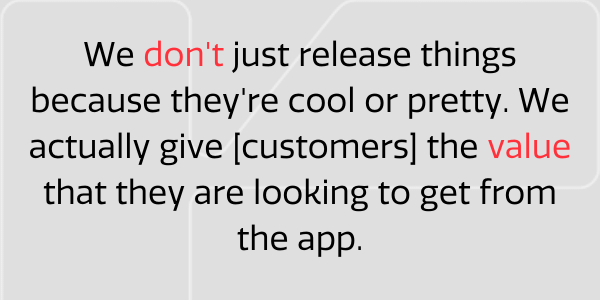
So we don't just release things because they're cool or pretty. We actually give them the value that they are looking to get from the app.
John: And I'm plus one on that we use a mixed panel to get the usage, you know, the qualitative product usage data. And then we combine that we have lots of places in the app where customers can give us, you know, you know, thumbs up, thumbs down and feedback, feedback, NPS type, qualitative feedback. And again, the challenge on all of that, depending on the scope, you’ve got tens of thousands of customers. Because again, when you have, you know, you can have a sea of data, but you don't have necessarily insight. And so that's going to be a challenge for any, um, kind of SaaS leader. Who's looking at that feedback loop? It's almost too much data at times.
What’s some advice you have for leading a remote team?
Josh: For sure, for sure. I want to switch gears now, to leadership and particularly I'm interested in leadership kind of in this remote era. So John we’ll start with you. You’ve been a leader in a number of SaaS and MarTech organizations over the years. What have you taken with you just from a general leadership principle of growing and scaling a team, but particularly, I guess with this remote flare, like in the last year, what are some things that you picked up to try to keep the culture coherent and consistent and to deliver a good experience to your team?
John: Yeah, so I think one of the principles that I've always appreciated is, around the power of focus as a leader. The tighter the focus, the greater the overall benefits to the business. There's a saying for startups...most of them will fail due to indigestion, not starvation. Over time I've seen that focus allows a greater excellence or chance of excellence, knowing your target customer more precisely than you do building a product that then meets their pain points.
John: So whether it's the company priorities, our values, our customer messaging that, allows people in a noisy world or a world of distractions or a world of anxiety and mental health, you know, aloneness...I think focus has just been more powerful. So I've appreciated it, you know, through my career, the power of focus.
Josh: Definitely. Yeah. I can say from experience, we've been a distributed team since 2015 and that's one of the challenges that comes up time and time again, is how do we make sure that, or our conversation isn't just transactional, but how do we create that space for people to relate on a human level?
John: I think companies that started that way or have been working in that model for a longer time. When you're meeting in person, there's a lot more inefficiency, I guess. And so when it comes in and like, you know, everyone's distributed, there's been a magnifying glass on what is the purpose of meetings? You know, so that's a great place in which to do it. And so for a lot of companies, they have to undo, how do we communicate? How do we drive outcomes? What's the purpose of us getting together?
And so people just shifted many, you know, bad meeting habits into bad zoom meeting habits, which gets to the fatigue piece, but I've found that companies that have been remote for a long time have built-in better systematic communication methods, better check-ins. And they've been much more time-efficient for the employee and consistent across the entire organization from onboarding to ongoing. I think companies that didn't have that luxury of having remote as a primary mechanism have those inefficiencies just had a magnifying glass in the last year.
Josh: That's a great point. Yeah. And Ruth, I'd love to turn this question to you as well. And with specific reference to, I guess, your military experience, cause I know both you and your brother, you come from a military background. So how, if at all, has that entered into your leadership style?
Ruth: So actually it's funny that you ask that because one thing both of us agree on because of our military experience is that we never want to work with people who don't want to be there because this is something that happens in the military when it's mandatory, people are there and you don't always have a way to motivate them. You can't incentivize them, you can't fire them. You basically have to kind of create motivation out of nowhere. And these can be very difficult and frustrating.
So one of the things we feel very strongly about is that if someone wants to work with us, they will do their job and in the best way possible. And we have a lot of patience for learning processes for human problems.
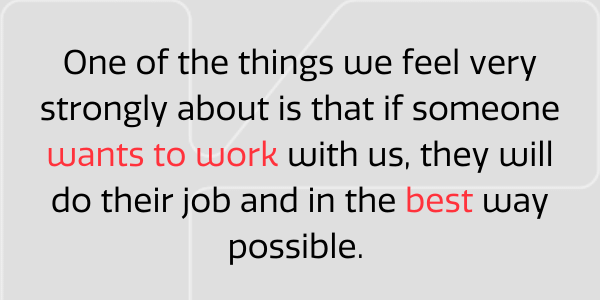
Ruth: Um, we always tend to say yes, even if it's not the most comfortable thing for the company at the moment, I never want my employees to feel like they are employees first. I always want them to know that we see them as people first.
Josh: I love that because it beats the transactional communication that we've been talking about, but it also just reemphasizes that you're human first and we care about what's going on in your life. So it's prioritized us in the meeting. Let's prioritize this in the agenda. Let's plan on talking about it because it's important. It's important to us. It's important to you.
What are some resources that you could recommend to our audience?
Josh: I'd love to kind of wrap up and just hear from you. What are some of the podcasts you're listening to, the books that you're reading, the blogs that you frequent? It doesn't have to be super aligned with leadership or entrepreneurship. It could be totally out of the box and just a guilty pleasure that you have, but what are some resources that you could share with our audience and recommend?
Ruth: I really enjoy Y Combinator that you mentioned before. And basically whenever there's something new that I need to learn, another place the businesses is going, that I feel like I don't know enough about, I search on YouTube and I just listen to other founders talk about it. That's the main resource I use for mindset and for basically the new ideas on where to take the business and how to go at and how to manage it.
John: Yeah, I'll add...I think there are lots of, you know, business podcasts. The SaaSter is one for sure. Seeking Wisdom With David Cancel out of drift is another one. So I think there's, lots of those, but I think the most exciting ones are... a lot of the ones there's like how, as a founder, you're really a leader as you talked about it. And so what is leadership? How do you become a better leader?
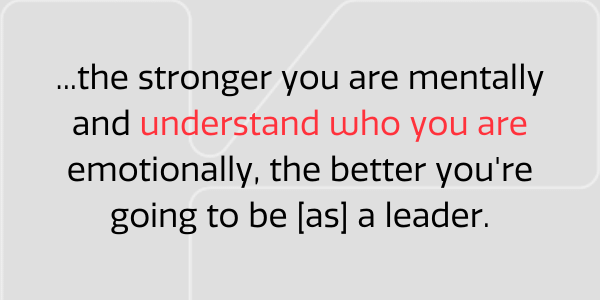
And I think to some of Ruth's points around, being a whole leader, the whole self, and being in tune, the stronger you are mentally and understand who you are emotionally, the better you're going to be a leader, which means the better you're going to lead others and your company is going to be successful.
John: So I think, um, podcasts like The Reboot from Jerry Colonna. He is a former VC, but he talks about the whole self as a leader as is really going to be helpful for founders as they go on that journey to understand who they are and realize also that they are human in this process because many times there's the perception of what a founder has to be and in defeat and tireless, always be positive and all that stuff, but in reality, they're human too.
John: Sometimes the best ideas are orthogonal. They're not direct, you know, it's the intersection of ideas and creativity that occurs there.
Josh: Yeah. Brilliant answers from both of you, you know, Ruth from your part, just being able to listen to other peers, just leveraging YouTube for the resource. It is the second-largest search engine in the world and maybe not over-indexing on thought leaders, but also listening from people who are in the trenches and just talking about it openly.
And then your point about getting outside of the echo chamber of business books or business podcasts, and borrowing ideas from other industries or other disciplines can be incredibly effective.
Josh: I want to thank you both for joining us and we'll have plenty of notes here in the show notes for where they can find both of your tools. I hope that people can reach out and keep the conversation going. But thank you both for your time today.


-AK-148968-preview.png?width=842&height=310&name=1.01-1x1px-Embertribe-(Client-Services)-AK-148968-preview.png)

















.png?width=810&height=810&name=TJ%20Jones%20-%20%20CoFounder%20EmberTribe%20(1).png)


%20-%20500x500%20-%20SP%20-%2045.01.png)
%20-%20500x500%20-%20SP%20-%2049.01.png)
%20-%20500x500%20-%20SP%20-%2057.01.png)


.png)